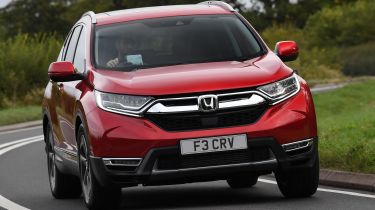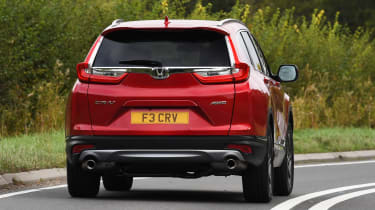Honda CR-V (2017-2023) review - Engines, performance and drive
The CR-V Hybrid engine is smooth and quiet, but isn't particularly efficient

Honda has made a number of significant changes to the steering and suspension settings of the latest Honda CR-V in order to improve its performance on challenging British roads. Overall, it has pretty much been a success. A quicker steering rack means there are fewer turns from lock-to-lock, giving the CR-V a more reactive and responsive feel when negotiating corners.
Much more emphasis has been placed on ride quality in the latest CR-V, so the suspension is much softer than before. That makes the CR-V significantly better at absorbing lumps and bumps in the road, increasing comfort for passengers. And although the trade-off is an increased amount of body roll in corners, many prospective owners will be happy to make this compromise.
The result of several enhancements throughout the car is that the CR-V offers more driving pleasure and is more comfortable to travel in than before, with high levels of refinement, low noise levels and a smooth ride. The driving position offers an excellent view out too, and although the CR-V is not an exciting car to drive, it’s undemanding, which will be a major plus for many owners.
0-62mph acceleration and top speed
For two years you could buy a CR-V with a 1.5 VTEC turbo petrol engine from the Civic hatchback, where it proves to be usefully powerful and efficient. In the CR-V, the issue is that it has a lot more work to do pulling a bigger and heavier vehicle around, and as a result it spends more time at higher revs. It has the power and torque to give decent acceleration, but the engine needs to be exercised quite hard to do so. The two-wheel-drive manual model can accelerate from 0-62mph in 9.3 seconds and reach 130mph, while the four-wheel-drive version manages 9.8 seconds and 129mph respectively.
The additional power and torque that comes with the CVT automatic gearbox option is welcome here, and in many ways is preferable to the manual because of its more relaxed operation. Demands for maximum acceleration can cause a typical CVT drone as the engine stays at high revs for an extended period. But when driven with restraint, it’s smooth and refined. The four-wheel-drive CVT model accelerates from 0-62mph in 10.0 seconds and can reach 124mph.
The CR-V Hybrid has a completely different set up, using a 2.0-litre petrol engine and an electric motor that also acts as the gearbox. The result is that the Hybrid is the most refined model in the range, with a smooth and quiet operation and a seamless switch between power modes. At low speeds the CR-V Hybrid can operate solely on electric power, while out on the motorway the electric motor cuts in to provide additional acceleration for overtaking. The two-wheel-drive Hybrid CR-V can achieve 0-62mph in 8.8 seconds and reach 112mph, while the four-wheel-drive version performs the same sprint in 9.2 seconds and can reach the same top speed.










